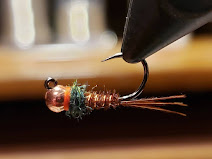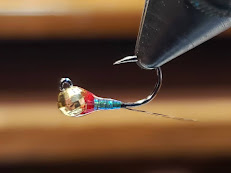While I definitely feel the "match the hatch" philosophy is entirely valid and more often than not painfully necessary in the arena of dry fly fishing, there is something to be said about fishing a fly in which an angler places their confidence. Maybe that fly proved useful in similar conditions or on a similar stretch of water during a previous outing or maybe it's a general pattern that simultaneously mimics a number of aquatic insects, albeit not as perfectly as an intricate pattern that almost flawlessly imitates one insect. The reality is that trout aren't always zeroed in on just one food source when feeding under the surface and, being advantageous survivors, will often take a number of options presented to them; for me it's those trusted patterns with which I take more risks, fish harder, and experiment with more that catch fish over the flies that haven't proven themselves effective over time even if they are the more logical selection.
I now present to you, the reader, some of my favorite confidence flies, each with an explanation of their specific application and why I have so much confidence in them. None of them are esoteric patterns that are being revealed to the world exclusively here and most are in fact quite commonly used, but I just want to show what works for me in the waters I fish.
Jig Frenchie
An all-around Euro nymphing favorite, the Jig Frenchie is an easy-to-tie pattern that mimics a number of aquatic insects. I typically use it in a size 18 or 20 as a dropper on my Euro rig and can count on it to pick up its share of fish throughout the day. Sometimes I'll even tie on a size 12 or 14 as my point fly if my other go-to point flies aren't proving effective in fast riffles and it'll usually produce fish.
Perdigon
My favorite dropper to fish in fast water, the weight of the Perdigon's tungsten bead and the fly's aerodynamic profile help it to get down where it needs to be quickly. While I've never found a conclusive answer as to what exactly the Perdigon imitates, the most plausible seems to be that it mimics smaller Chironomid larva and that the flash, hot spot, and UV resin work as simple attractors when seemingly nothing else will. I'll throw out my own theory that they may even mimic smaller fish fry as I've had success on the swing or stripping them in at the end of a drift while Euro nymphing a small streamer as my point fly. Whatever the case, I exclusively fish them as a dropper in any size from 14-20.
Girdle Bug
When I was first shown a Girdle Bug and told how effective it is, I was dumbfounded. I had spent so much time and effort learning to tie intricate stonefly patterns and I just couldn't process the idea that this mess of rubber legs and chenille could catch fish as a stone imitation. The first time I fished one as my point fly on a Euro rig, I was sold within minutes. Not only did I net a ton of trout that day all on girdles, but I capped it off with a new personal-best wild brown and my first brown over 20-inches. Two things struck me about the Girdle Bug that day: 1.) the takes were more aggressive than anything I had experienced in years of nymphing, with the rod bent and line peeling through my fingers before I could even register what had happened and 2.) when wet, the girdle bug is actually a solid imitation. The wet chenille creates a perfect segmentation of the body, which I later realized is accentuated by tying with variegated chenille and barred legs.
 |
| See what I mean about the segmentation when wet? |
Since the maturation time for a stonefly in the nymph stage is roughly two years, if you're fishing a stream that holds stones you can count on them always being on the bottom and always being on the menu, making the Girdle Bug an extremely effective go-to pattern that's caught roughly 75% of all of my trout over 15-inches in the past few years.
Soft Hackle Pheasant Tail
I spend a lot of time on small, isolated mountain streams fishing a 2-weight glass rod for tiny wild and native trout and one thing I've learned in the past few years is that the challenge isn't getting those trout to eat, it's not spooking them. Smaller streams typically don't have the same diversity of aquatic insect life as a larger river and the competition for what food there is can be fierce given the small surface area the water covers and the dense concentration of trout that often occupy it. Therefore, if you have a quiet approach you can get these advantageous eaters to aggressively take a number of patterns if properly presented. My absolute favorite pattern for these streams is a simple Beadhead Soft Hackle Pheasant Tail Nymph.
From numerous encounters with old-timers on the water and testing out their advice I've definitely found that bigger is better on these tiny streams. When nymphing, I use a size 12 (weighted only with the brass bead and lead-free wire around the hook shank) as my point fly and when using it as a dropper on a dry-dropper rig I tie on the same fly in a size 16 or 18. I think the effectiveness of this pattern comes not so much from its ability to mimic a number of aquatic insect species, but from the fact that the size, bead, and movement of the soft hackle all serve as attractors to get the trout's attention. In crystal clear water less than a foot deep I've seen browns fly out from under ledges on the opposite bank to whack this fly at full speed. While I prefer to use it on tiny mountain streams, the Soft Hackle Pheasant Tail is a classic, versatile pattern that has so many applications on any stream in any conditions.
Sulphur Jig Frenchie
In my area as in many places, Spring is the most active time of year for trout and the most productive time to be on the water. On those rare Spring days when I'm having a hard time connecting with fish, I often find that it's because the trout are zeroed in on sulphur nymphs in the current and I'm stubbornly sticking to my aforementioned Girdle Bug/Perdigon tandem. When I finally stop, think, flip some rocks, and ultimately switch to a sulphur-colored jig Frenchie (size 14-18), the problem is almost always solved.
Simple Sculpin Streamer
I'm just this year getting serious about upping my streamer game. My wife got me a great 6-weight setup for Christmas and I spent much of the Winter tying a variety of streamer patterns, researching various techniques and presentations, and picking the brains of dedicated streamer fishermen I know. One thing I was mildly surprised to find was the amount of emphasis anglers place on using the rod tip when presenting streamers and I've been practicing it in a number of ways such as twitching the rod tip while stripping in line, twitching it while letting the fly dangle in the current, and, while it may seem like a technique reserved for bass fishermen with a baitcaster, jigging streamers off the bottom. Not only is the Simple Sculpin Streamer a quick, easy pattern to tie, but it's also an extremely effective jigging streamer, even on streams that don't have sculpins. I typically tie them on size 2-6 Gamakatsu Stingers with small sized Fish Skull Sculpin Helmets and barred olive rabbit strips.
Slumpbuster
There's a lot of innovation in streamer patterns these days and innovation is always a good way to fight off stagnation. However, despite all of the new, exciting patterns out now, I'm still most impressed by how realistically classic rabbit strip streamers such as the Slumpbuster move in the water and how effective and versatile they can be on the small-to-medium-sized streams that I fish. There's nothing like intentionally slamming one in at the edge of the opposite bank where you know there's a drop-off holding fish and watching a big brown come up and crush it on the first strip immediately after impact; for more traditional streamer techniques like this I tie Slumpbusters on size 1-4 Gamakatsu Stinger hooks or Ahrex Predators with tungsten coneheads.
My second favorite way to fish a Slumpbuster is to Euro nymph it as a point fly. The takes are almost as aggressive as those I previously described getting on the Girdle Bug and they can happen at any time while sinking, dead-drifting, swinging, or stripping in. For this technique, I tie them on size 12 traditional 3-4x streamer hooks with a small tungsten cone and I use pine squirrel strips instead of rabbit strips not only for the ease of tying the more narrow profile onto a smaller hook, but also for the fact that pine squirrel actually undulates in the current better that rabbit strips, if that's even possible.
Olive Thread Frenchie
Between the prevalence of caddis larva and baetis nymphs in the Northeast (especially in the Spring) you can't go wrong with any nymph pattern in an olive color and the Olive Thread Frenchie was a huge hit for me this past Spring. I tie them in sizes 14-20 and use them interchangeably as a point fly and a dropper. My most effective use of them came when fishing them as a point fly in size 14 with a black nickel bead in low, clear water.
Olive X Caddis
 |
| I tie mine with brown hackle to mimic legs on the underside of the fly. |
The Olive X Caddis in a size 12 is my favorite small mountain stream dry fly not only because of how aggressively native brookies and other wild trout will absolutely crush it, but also for how easy it is to tie, how visible it is on the surface, and how buoyant it is even when trailing a beaded nymph dropper like the Soft Hackle Pheasant Tails I previously mentioned. I'm sure anyone out West reading this would not consider a size 12 to be large, what with the huge caddis and sedge that hatch out there, but consider the fact that the average trout crushing these size 12 dries on these small brooks is about 6-inches in length.
The only time I don't use this dry (or any dry typically) is in the dead of Winter, but I know people who fish big dries such as Stimulators on these tiny streams and have success in the colder months. I find that when the flows are low in the warmer months, a dry-dropper rig with an Olive X Caddis trailing a Soft Hackle Pheasant Tail is possibly the most effective setup I've ever used to catch wild trout, albeit smaller ones.
Feel free to message me here or DM me on Instagram with any questions about tying or fishing these patterns.








